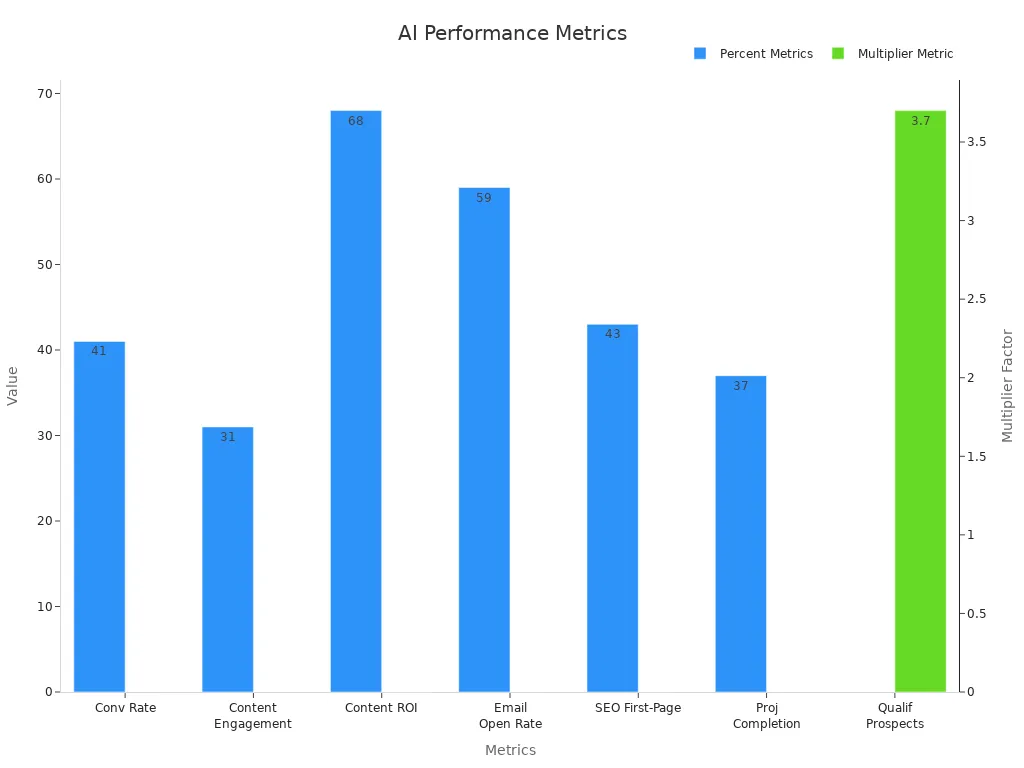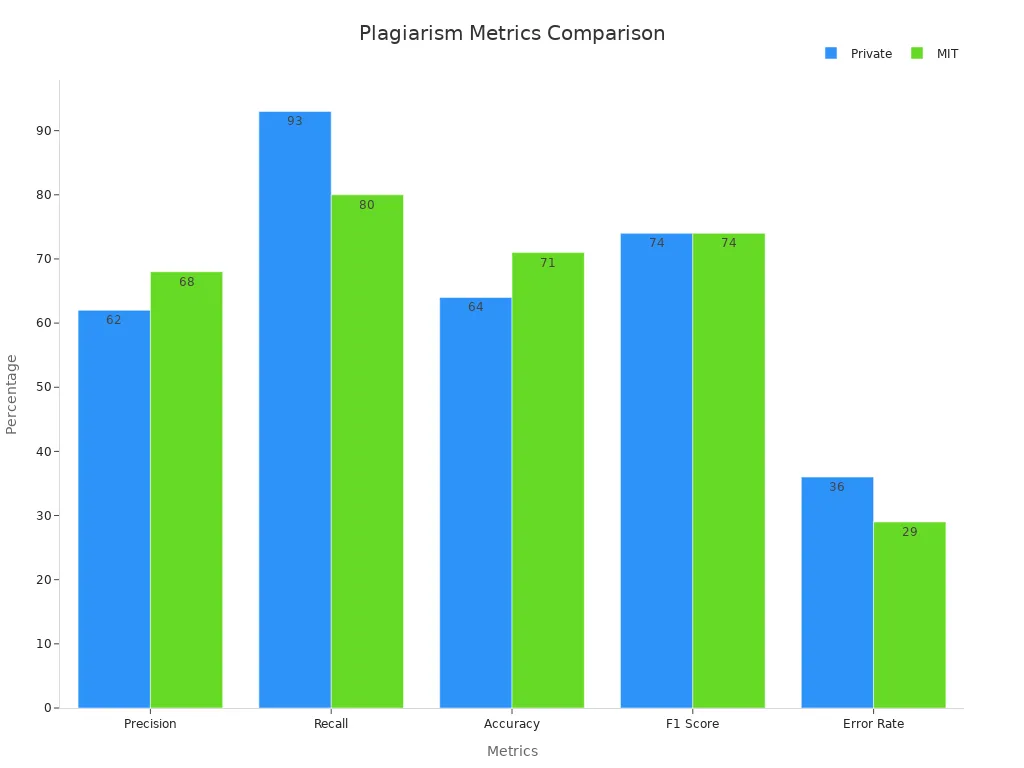
Imagine cutting hours off your research workload. That’s what an AI writing tool can do for you. These tools don’t just help with writing; they simplify everything—from gathering sources to polishing the final draft. In fact, over 73% of researchers already use or explore AI tools, with 39.6% calling them “very effective.” Evaluating features like accuracy, cost, and academic integrity, the best tools stand out for their ability to save time and boost productivity.
Key Takeaways
-
AI tools help you save time on research. This lets you spend more time analyzing and understanding your work.
-
These tools also help organize ideas, making writing easier and more creative.
-
AI citation tools make adding references quick and accurate, saving effort.
AI Writing Tools for Research and Information Gathering

Best Tools for Literature Review
When it comes to literature reviews, AI tools can save you hours of effort. Instead of manually sifting through hundreds of papers, tools like Elicit, Connected Papers, and Iris.ai do the heavy lifting for you.
|
Tool |
Key Features |
User Feedback |
|---|---|---|
|
Elicit |
Analyzes numerous papers, synthesizes data, extracts methodologies |
Significantly reduced analysis time; exceeded expectations in data extraction accuracy. |
|
Connected Papers |
Visualizes relationships between research papers |
Saves hours of effort; uncovers relevant papers from allied fields. |
|
Iris.ai |
Understands scientific literature beyond keyword matching |
Game-changer in processing technical content; saves many hours of unnecessary effort. |
These tools don’t just speed up the process; they also improve accuracy. For example, Elicit excels at extracting methodologies, while Connected Papers helps you discover connections between studies you might have missed. Iris.ai goes a step further by understanding scientific literature beyond simple keyword searches, making it ideal for tackling complex topics.
AI tools like these also enhance reliability. By automating systematic reviews and data extraction, they ensure thoroughness and reduce human error. You’ll find that key data points become more accessible, allowing you to focus on interpreting results rather than hunting for them.
Tools for Finding Credible Sources
Finding credible sources is often the trickiest part of research. AI tools like Consensus and scite simplify this process by using machine learning and natural language processing to deliver summaries and consensus analyses.
Consensus helps you build a robust citation library, making it easier to manage sources and maintain high academic standards.
Scite’s ability to classify papers based on whether they support or contradict a publication is a game-changer. It lets you quickly assess what’s affirmed or disputed in the literature, saving you time and ensuring your research aligns with the scientific process.
These tools don’t just find sources; they help you understand how the academic community views specific topics. Whether you’re analyzing disputed findings or building a case for your argument, they ensure your sources are both credible and relevant.
AI Writing Tools for Organizing and Structuring Ideas
Mind-Mapping and Outlining Tools
Ever feel like your ideas are all over the place? That’s where AI-powered mind-mapping and outlining tools come in handy. Tools like MindMeister, XMind, and Coggle help you visually organize your thoughts, making it easier to see connections and structure your paper logically.
These tools let you create dynamic mind maps that adapt as your ideas evolve. For instance, MindMeister allows you to collaborate in real time, which is perfect for group projects or brainstorming sessions. XMind offers templates tailored for academic writing, so you can quickly outline your introduction, body, and conclusion. Coggle keeps things simple with an intuitive interface that’s great for beginners.
Using these tools doesn’t just save time—it also boosts creativity. Students have reported that AI tools help them generate fresh perspectives and supporting arguments, encouraging broader thinking in their writing process. They also act as catalysts for deeper exploration of ideas during group discussions.
By visually mapping your ideas, you’ll find it easier to stay focused and avoid tangents. Plus, you’ll have a clear roadmap to guide your writing.
AI-Powered Note-Taking Tools
Taking notes can feel tedious, but AI-powered tools like Notion AI, Evernote, and Obsidian make it a breeze. These tools don’t just store your notes—they organize, summarize, and even suggest connections between them.
Imagine cutting your study time by nearly half. That’s what students have achieved with these tools. One biology student, Alex, reduced his weekly study hours from 10 to 6 while maintaining top grades. Tools like Notion AI can summarize lengthy articles, while Obsidian links related notes, helping you see the bigger picture.
Students who use AI note-taking tools often report enhanced productivity. They spend less time sorting through information and more time focusing on what matters—understanding and applying their knowledge.
With these tools, you’ll never lose track of important details. They’re like having a personal assistant for your academic life, keeping everything organized and accessible.
AI Writing Tools for Drafting Academic Papers
Tools for Generating Content
Drafting academic papers can feel overwhelming, especially when you're staring at a blank page. That’s where AI writing tools come to the rescue. These tools don’t just generate content—they help you organize your thoughts and create a solid foundation for your paper. Popular options like ChatGPT, Writesonic, and Jasper AI are designed to assist with everything from brainstorming ideas to drafting paragraphs.
Here’s how they make your life easier:
-
ChatGPT: Perfect for generating initial drafts or exploring different angles for your topic. It’s like having a brainstorming partner that never runs out of ideas.
-
Writesonic: Tailored for academic writing, it offers templates for essays, research papers, and even thesis statements.
-
Jasper AI: Known for its versatility, Jasper can adapt its tone and style to match academic requirements, making it ideal for formal writing.
These tools don’t just save time—they boost productivity. According to recent studies, AI-generated content has a 41% higher conversion rate and 31% better engagement metrics compared to traditional methods.
|
Metric Description |
Value |
Source |
|---|---|---|
|
Higher conversion rate with AI-optimized content |
41% |
HubSpot Research, 2023 |
|
AI content engagement metrics |
31% |
Northwestern Media Research, 2023 |
|
Faster project completion with AI tools |
37% |
Workfront State of Work, 2023 |

Using an AI writing tool can also help you overcome writer’s block. These tools suggest content ideas, provide summaries, and even format citations. You’ll find yourself spending less time stuck and more time refining your arguments.
Tools for Improving Writing Clarity and Style
Even the best ideas can fall flat if they’re not communicated clearly. That’s why improving your writing style is crucial, and AI tools like Grammarly, Paperpal, and Instatext excel in this area. They don’t just check grammar—they enhance your academic tone and ensure your writing is concise and impactful.
Let’s break it down:
-
Grammarly: Great for catching grammar mistakes and improving readability. It’s perfect for general writing but may need fine-tuning for academic papers.
-
Paperpal: Specifically designed for academic writing, it offers high accuracy and compares favorably to human editors.
-
Instatext: Focuses on clarity, making your sentences more concise and easier to understand.
|
AI Tool |
Performance Metrics |
Comparison to Human Editors |
Effectiveness in Academic Writing |
|---|---|---|---|
|
Paperpal |
High accuracy |
Compared favorably |
Most efficient for academic texts |
|
Grammarly |
Moderate accuracy |
Good but less effective |
Useful for general writing |
|
Writefull |
Variable |
Needs improvement |
Helpful for specific tasks |
|
Instatext |
Moderate |
Comparable |
Good for clarity |
|
AJE Digital |
High |
Effective |
Strong in grammar and style |
These tools don’t just fix errors—they help you refine your writing style. For example, Paperpal is particularly effective for academic texts, ensuring your tone aligns with scholarly standards. Grammarly, while less specialized, is still a solid choice for improving readability. Instatext shines when you need to simplify complex sentences without losing meaning.
Using these tools can save you time and reduce stress. They allow you to focus on your content while ensuring your writing is polished and professional. Plus, they’re a lifesaver for non-native English speakers, helping you communicate your ideas with confidence.
AI Writing Tools for Editing and Proofreading

Grammar and Style Checkers
You know how frustrating it can be to spot every single grammar mistake in your writing. That’s where grammar and style checkers come to the rescue. These tools don’t just catch typos—they help you refine your writing and make it more professional. Popular options like Grammarly, ProWritingAid, and LanguageTool are designed to identify errors and suggest improvements that elevate your academic writing.
Here’s why they’re so effective:
-
They provide consistent and unbiased evaluations, ensuring your writing meets high standards.
-
Automated processes speed up the review cycle, saving you hours of editing time.
-
Some tools even generate analytics on your language patterns, helping you understand and improve your writing habits.
Studies show that manuscripts with fewer grammatical errors have a 15% higher acceptance rate in top-tier journals. That’s a big deal, especially if you’re aiming for publication. Precise language isn’t just about looking polished—it’s about avoiding misunderstandings. In fields like medicine, a misplaced modifier could lead to harmful misapplications. These tools ensure your writing is clear and accurate, reducing the risk of errors.
Take Grammarly, for example. It’s great for catching common mistakes and improving readability. ProWritingAid goes a step further by analyzing your writing style and offering suggestions to make your sentences more concise. LanguageTool is perfect for multilingual writers, as it supports over 20 languages. Whether you’re drafting a research paper or polishing your thesis, these tools make editing faster and easier.
Tools for Enhancing Academic Tone
Writing with an academic tone can feel like walking a tightrope. You want your work to sound professional, but you don’t want it to be overly complicated or dry. That’s where tools like Paperpal, Writefull, and Instatext shine. They help you strike the perfect balance between clarity and sophistication.
Here’s how they work:
-
Paperpal is specifically designed for academic writing. It ensures your tone aligns with scholarly standards while keeping your sentences concise.
-
Writefull uses AI to suggest improvements based on real academic texts, making your writing more authentic and impactful.
-
Instatext simplifies complex sentences, helping you communicate your ideas clearly without losing depth.
These tools don’t just enhance your tone—they make your writing more engaging. Imagine presenting your research in a way that’s both professional and easy to understand. That’s the kind of impact these tools can have. Plus, they’re a lifesaver for non-native English speakers, helping you express your ideas with confidence.
Using an AI writing tool for tone enhancement can also boost your chances of publication. Editors often look for manuscripts that are well-written and easy to follow. By refining your tone, you’ll make a stronger impression and stand out from the crowd.
AI Writing Tools for Citation and Referencing
Citation Generators
Citing sources can feel like a chore, but AI-powered citation generators make it quick and painless. Tools like Zotero, Cite This For Me, and EndNote help you create accurate citations in seconds. Whether you need APA, MLA, or Chicago style, these tools have you covered.
Here’s why they’re a game-changer:
-
They access databases with over 200 million scientific articles and 330,000 fact-checks from trusted publications.
-
You can save up to 50% of the time spent verifying sources and formatting citations.
|
Feature Description |
Benefit |
|---|---|
|
Access to vast databases |
Ensures citations are accurate and reliable. |
|
Time-saving capabilities |
Cuts citation management time in half. |
|
Trusted by major organizations |
Used by Associated Press and BBC for thousands of articles. |
These tools don’t just save time—they also reduce stress. Imagine finishing your bibliography in minutes instead of hours. Plus, they help you avoid common mistakes, like missing details or formatting errors.
Tools for Managing References
Keeping track of references can get messy, especially when you’re juggling multiple sources. AI tools like Mendeley, RefWorks, and Paperpal’s AI Reference Finder simplify this process. They organize your references, suggest related articles, and even help you cite them correctly.
Tools like Paperpal give you access to over 250 million research articles, streamlining your research and improving the quality of your writing.
Different databases offer unique benefits:
-
Scopus and Web of Science provide citation counts and h-index metrics but require subscriptions.
-
Google Scholar offers broader access and includes documents beyond traditional journals.
-
OpenAlex and OpenAIRE Graph focus on open access, covering pre-prints and theses.
Managing references becomes effortless with these tools. You’ll spend less time searching and more time writing. Plus, they help you stay organized, ensuring your citations are always accurate and complete.
AI Writing Tools for Final Proofreading and Plagiarism Checking
Plagiarism Detection Tools
Plagiarism can derail your academic work, but AI tools make it easier to catch and prevent it. Tools like Turnitin, Grammarly’s Plagiarism Checker, and Copyscape scan your text against massive databases to identify similarities. They don’t just flag copied content—they help you understand how to fix it.
Here’s what makes these tools effective:
-
They continuously monitor platforms for new content and instantly compare uploads against existing databases.
-
They excel at identifying similarities with sources like Wikipedia but struggle with paraphrased text and open-access papers.
|
Metric |
Private Dataset |
MIT Plagiarism Dataset |
|---|---|---|
|
Precision |
62% |
68% |
|
Recall |
93% |
80% |
|
Accuracy |
64% |
71% |
|
F1 Score |
74% |
74% |
|
Error Rate |
36% |
29% |

While these tools perform well with straightforward matches, they sometimes misclassify human-written responses, leading to false positives. That’s why it’s important to review flagged sections carefully. Users often praise the similarity reports for their clarity and ease of use, making it simpler to benchmark features against other systems.
Tools for Ensuring Formatting Compliance
Formatting academic papers can feel like a tedious chore, but AI tools like Typeset, EndNote, and Ref-N-Write simplify the process. These tools ensure your work complies with strict formatting guidelines, whether it’s APA, MLA, or Chicago style.
Here’s how they help:
-
They automate citation formatting, saving you hours of manual adjustments.
-
They highlight inconsistencies in headings, margins, and font styles, ensuring your paper looks professional.
Typeset stands out for its ability to format entire manuscripts in minutes. You can upload your paper, select a journal template, and let the tool handle the rest.
These tools don’t just save time—they reduce stress. Imagine submitting your paper without worrying about missed formatting details. Plus, they’re perfect for students juggling multiple assignments, helping you focus on your content instead of the nitty-gritty of formatting.
Choosing the right AI writing tool can transform your academic writing experience. Tools like ResearchFlow, Wordvice AI, and Semantic Scholar stand out for their unique features. For example, Wordvice AI offers real-time grammar and style feedback, while ResearchFlow excels at organizing knowledge visually. These tools help you work faster and produce polished, professional papers.
Here’s what we recommend:
-
Students: Use Wordvice AI for grammar and citation help.
-
Researchers: Try ResearchFlow for multi-document comparisons.
-
Professionals: Semantic Scholar is perfect for finding research gaps.
Remember, ethical use of AI tools is key. They’re here to assist, not replace your critical thinking. Use them responsibly to enhance your skills and maintain academic integrity.
FAQ
What is the best AI tool for academic writing?
It depends on your needs. For drafting, try ChatGPT. For editing, Grammarly works well. Need citations? Go for Zotero or EndNote.
Are AI tools reliable for academic integrity?
Yes, but use them responsibly. AI tools assist with writing and research but don’t replace your critical thinking or original ideas. Always double-check their outputs.
Can AI tools help non-native English speakers?
Absolutely! Tools like Grammarly and Instatext improve grammar and clarity, making your writing more professional and easier to understand.
💡 Tip: Combine multiple tools to maximize your results. For example, use Grammarly for grammar and Zotero for citations.





